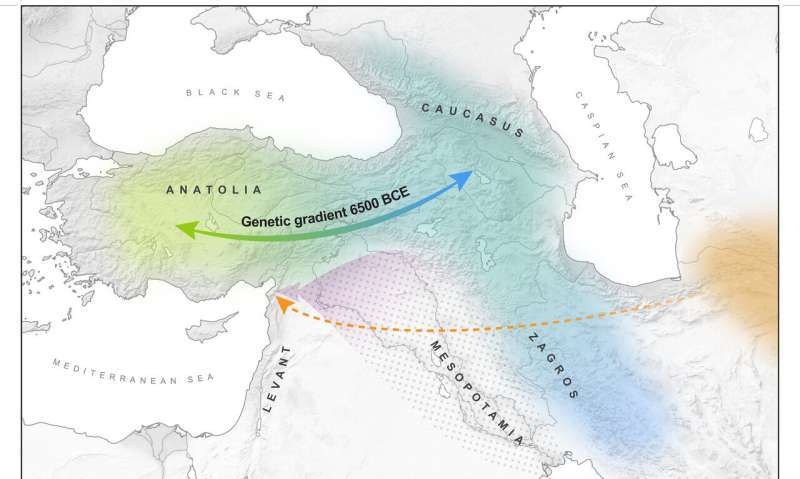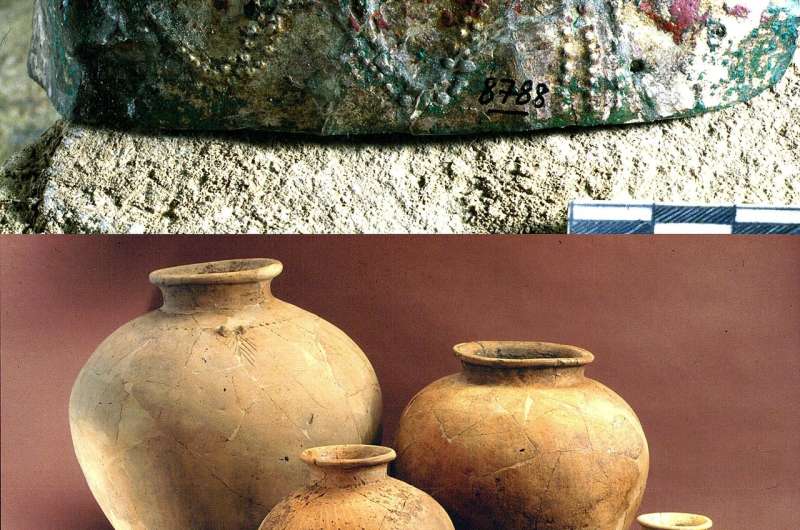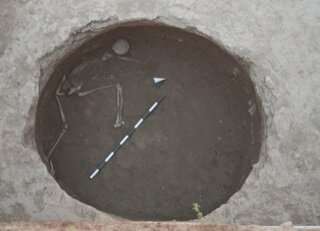A partial map of West Asia, which includes Anatolia (present-day Turkey), the Northern Levant, and the Southern Caucasus. An international team of researchers showed populations from Anatolia and the Caucasus started genetically mixing around 6,500 BC and that small migration events from Mesopotamia 4,000 years ago brought further genetic mixture to the region. The orange marker shows the route from Central Asia. DNA from a lone ancient woman revealed proof of long distance migration during the late Bronze age about 4,000 years ago from Central Asia to the Mediterranean Coast. Credit: the Max Planck-Harvard Research center for the Archaeoscience of the Ancient Mediterranean
New research on one history's most important trading hubs provides some of the earliest genetic glimpses at the movement and interactions of populations that lived in parts of Western Asia between two major events in human history: the origins of agriculture and the rise of some of the world's first cities.
The work reveals how a high level of human movement in the region not only led to the spread of ideas and material culture but to a more genetically connected society well before the rise of cities, not the other way around, as previously thought.
The researchers, made up of an international team of scientists including Harvard anthropology professor Christina Warinner, looked at DNA data from 110 skeletal remains in West Asia dated 3,000 to 7,500 years ago. The remains came from archaeological sites in the Anatolia (present-day Turkey), the Northern Levant which includes countries on the Mediterranean coast such as Israel and Jordan, and countries in the Southern Caucasus which include present-day Armenia and Azerbaijan.
Based on their analysis, the scientists describe two genomic events that occurred around 8,500 years ago and 4,000 years ago that pointed to long-term genetic mixing in the region and subtle population movements within the area, shedding light on a long-standing question.
"Within this geographic scope, you have a number of distinct populations, distinct ideological groups that are interacting quite a lot and it hasn't really been clear to what degree people are actually moving or if this is simply just a high contact area from trade," said Warinner, assistant professor of anthropology at the Faculty of Arts and Sciences and the Sally Starling Seaver Assistant Professor at the Radcliffe Institute for Advanced Study. "What we can see is that rather than this period being characterized by dramatic migrations or conquest, what we see is the slow mixing of different populations, the slow mixing of ideas, and it's percolating out of this melting pot that we see the rise of urbanism—the rise of cities,"
Above: Copper-silver diadem with Transcaucasian connection from the Royal Tomb in Arslantepe, Eastern Turkey. Below: Mesopotamian-related pottery in Arslantepe (palace period) Credit: Missione Archeologica Italiana nell'Anatolia Orientale, Sapienza Univ. of Rome(photographer: Roberto Ceccacci)
The study was led by the Max Planck-Harvard Research center for the Archaeoscience of the Ancient Mediterranean and published in the journal Cell. Warinner was a senior author on the paper.
Historically, Western Asia, which includes the modern-day Middle East, is one of the world's most important geographical locations. Early on it not only created some of humanity's earliest cities but its early trade routes laid the foundation for what would become the Silk Road, a route that commercially linked Asia, Africa, and Europe.
Even prior to being connected with other regions, however, populations across Western Asia had already developed their own distinct traditions and systems of social organization and complexity. The areas studied in this paper played major roles in this development from early farming to pastoral communities to early state-level societies.
With the study, the researchers wanted to fill in some of the anthropological gaps between the origins of agriculture and of cities to better understand these different communities came together to eventually form cities.
Skeletal remains of 'Lady in the Well' from the site of Alalakh in Hatay, Turkey. Credit: Murat Akar © Alalakh Excavations Archive
"What we see in archeology is that the interconnectivity within Western Asia increased and areas such as Anatolia, the Northern Levant, and the Caucasus became a hub for [the] exchange of ideas and material culture," said Eirini Skourtanioti, a Ph.D. student at the Max Plank Institute and the lead author of the study, in a video accompanying the release of the paper. "The goal of our study was to understand the role of human mobility throughout this process."
The researchers included an international team of authors from many disciplines and countries, including Australia, Azerbaijan, France, Italy, Germany, South Korea, Turkey, and the United States. They gathered the 110 ancient remains and took samples from their teeth and part of the temporal bone called the petrous, which is part of the inner ear. The samples from the skeletons were all previously excavated and were housed in different museums and labs around the world. The genetic analysis was all conducted by scientists at the Max Planck Institute, including Warinner.
In the paper, the authors outline how approximately 8,500 years ago, populations across Anatolia and the Southern Caucasus began genetically mixing. It resulted in a gradual change in genetic profile that over a thousand years slowly spread across the both areas and entered into what is now Northern Iraq. Known as a cline in genetics, this mixture indicated to the researchers ongoing human mobility in the area and the development of a regional genetic melting pot in Anatolia and its surrounding areas.
The other shift researchers detected wasn't as gradual. They looked at samples from the ancient cities of Alalakh and Ebla in what is today southern Turkey and northern Syria and saw that around 4,000 years ago the Northern Levant experienced a relatively sudden introduction of new people.
The subtle genetic shifts points to a mass migration event. The timing of this migration corresponds with a massive drought in Northern Mesopotamia. It is likely where the migrants that entered the Northern Levant area originated from. The scientists can't be sure because there are currently no well preserved genomes for Mesopotamia.
Along with findings on interconnectivity in the region, the paper presents new information about long distance migration during the late Bronze age about 4,000 years ago. Researchers determined that a lone corpse, found buried in a well, genetically belonged in Central Asia at the time, not at a site that is part of present-day Turkey.
"We can't exactly know her story, but we can piece together a lot of information that suggests that either she or her ancestors were fairly recent migrants from Central Asia," said Warinner, who is also a group leader in the Department of Archaeogenetics at the Max Planck Institute. "We don't know the context in which they arrived in the Eastern Mediterranean but this is a period of increasing connectivity in this part of the world."
The corpse had many injuries and the way she was buried indicates a violent death. Warinner hopes more genomic analysis can play some type of role in unraveling the ancient woman's story.
For Warinner, who earned her master's in 2008 and her Ph.D. in 2010 from the Graduate School of Arts and Sciences, these types of studies are proof of the insights DNA analysis can provide when more traditional clues don't tell the full story.
"What's really interesting is that we see these populations are mixing genetically long before we see clear material culture evidence of this—so, long before we see direct evidence in pottery or tools or any of these more conventional archaeological evidence artifacts," Warinner said. "That's important because sometimes we're limited in how we see the past. We see the past through artifacts, through the evidence people leave behind. But sometimes events are happening that don't leave traces in conventional ways, so by using genetics, we were able to access this much earlier mixing of populations that wasn't apparent before."
More information: "Genomic History of Neolithic to Bronze Age Anatolia, Northern Levant, and Southern Caucasus," Cell (2020). DOI: 10.1016/j.cell.2020.04.044
Journal information: Cell
Provided by Harvard University


























